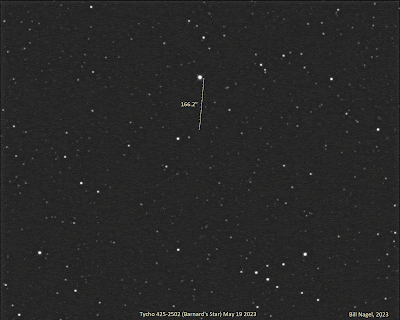NGC 7006 in Delphinus is one of my favorite globular clusters. It's not as spectacular as M5, M3, M13, M22, at least from a visual sense, but understanding it's semi-remoteness compared to the others makes it special. I have a fond memory of my first glimpse of this cluster back in 1988 with my Celestron C8 SCT. With my '83 (second edition) copy of Peterson's Field Guide to the Stars (which I still have) and using the setting circles of the Super Polaris, I found the small smudge of light of the globular even through the light pollution dome of Philadelphia to the Southwest. Distance measurements to NGC 7006 since the field guide's printing have been refined with new estimates of 135,000 ly compared to 185,000 ly referenced in the book.
Bill's Astro Blog
CCD AstroPhotography By Bill Nagel
Tuesday, September 30, 2025
NGC 7006
Thursday, December 26, 2024
2018 images
In 2018 I bought my SX694 to give me a bit more F.O.V., slightly smaller pixels and higher Q.E. compared to my Starlight Xpress SXVF-H9. Some of the data I had acquired with the newer camera was never processed until recently. It's still a work in progress but I'll post some of the images here as I work through them.
One of the issues I had using the newer camera was the presence of a circular gradient I could never correct with flat fields therefore not allowing me to fully stretch the data to my liking. This gradient was not apparent in my H9 images due to the smaller field with the AT10RC. Only a few years ago did I find, by chance, this issue was caused by the baffle tube being a bit too short allowing light from the telescope aperture to hit the inside of the baffle creating the rings. All my images from 2011 till mid-2022 with the AT10RC were taken without the baffle extension.
The extension was purchased from here. https://buckeyestargazer.net/Store/GSOBaffleEXT.php
 |
| Flat W/O Baffle |
 |
| Flat W/Baffle |
With some newer tools available in Astroart, I'm revisiting these older stacks to see what I can salvage for display.
Monday, November 11, 2024
Eris (2024)
Dwarf Planet Eris
Physical size: 2,377 km. (1,477 mi.)
Scope: Astrotech AT10RC @F/8 (2000 mm)
Exposures: L= 22 x 180 seconds (66 minutes total)
Acquired, calibrated, stacked (Sum) in Astroart 9
Processing Notes:
Palomar 5 (UGC 9792)
Palomar 5 in Serpens
Distance: 75.6 kly
Physical size: ~152 ly
Guider: Starlight Xpress Lodestar off-axis.
Scope: Astrotech AT10RC @F/8 (2000 mm)
Exposures: L= 13 x 120 seconds
Acquired, calibrated, stacked (Median) in Astroart 8
Processing Notes:
Thursday, July 4, 2024
NGC 5053
NGC 5053 in Coma Berenices
Distance: 56.7 kly
Physical size: ~160 ly
Guider: Starlight Xpress Lodestar off-axis.
Scope: Astrotech AT10RC @F/8 (2000 mm)
Exposures: L= 24 x 90 sec; R,G,B = 7 x 90 seconds each.
Acquired, calibrated, stacked (Median) LRGB combined in Astroart 8
Processing Notes:
DDP stretch on Lum.
Monday, April 8, 2024
April 8th 2024 Partial Solar Eclipse
Monday, May 22, 2023
Barnard's Star 2007 - 2023
Here is a 2 frame .GIF showing the proper motion of Barnard's Star over 16 years.
I have been taking images of Barnard's Star every year since 07' and will at some point make a comparison with even more references.
The 2007 version was one of the first images taken when I got my Starlight Xpress SXVF-H9 camera.
This version was only a stack of (3) 30 second subs through a Celestron C11 with an Optec F5 focal reducer. A Focal length of 1400mm and no filters used. The original subs had quite a strong optical vignette that I was able to correct with Astroart's gradient filters.
The 2023 version was with my current setup, AT10RC @F8 2000mm, SX-694 & LPS-D3 filter. A stack of (39) 20 second exposures.
The SNR was higher in the 2007 image since it was taken @F5 on a 280mm SCT and I needed to adjust the histogram quite a bit to closely match the 2023 version in both background and star intensity. Light pollution levels were also much lower for me back in 07'. Since that time, LED street lights have been installed all over the area including my street along with most of my neighbors having security lights with no shielding.
Barnard's Star (Tycho 425-2502-1) has the largest known proper motion of a star across our sky 10.39" arc per year. It's also the 4th nearest star to our Solar System (5.96 ly.) after the Alpha Centauri system. For me it's the closest visible star (with optical aid) from my latitude.










.jpg)






